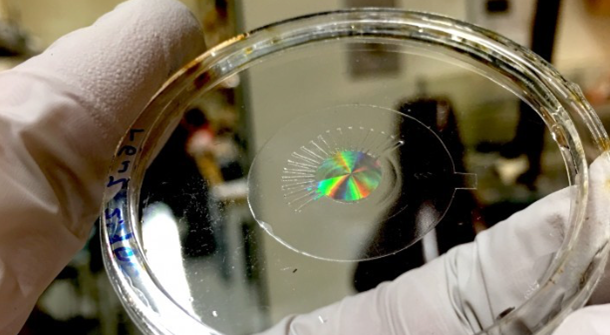Forward-Looking Metalens
Adaptive Metalens

Image of silicon metalens mounted on a transparent, stretchy polymer film, without any electrodes. The colorful interior is produced by the large number of nanostructures courtesy of the Capasson Laboratory. Alan She, Shuyan Zhang, Samuel Shian, David R. Clarke, and Federico Capasso, "Adaptive metalenses with simultaneous electrical control of focal length, astigmatism, and shift," Sci. Adv. 4, eaap9957 (2018) ![]()
Inspired by the human eye, a team led by Clarke at the Harvard MRSEC has reported in Science Advances an adaptive metalens that is a flat, electronically-controlled artificial eye. This new lens which combines breakthroughs in artificial muscle and lens technologies simultaneously controls three of the major factors in a blurry picture: focus, astigmatism, and image shift. Because of the dynamic corrections the metalens functions in ways the human eye cannot. This demonstrates the feasibility of embedded optical zoom and autofocus for cell phone cameras, eyeglasses, and augmented reality devices. The work provides the possibility of unifying two industries: semiconductor manufacturing and lens-making whereby the same technology to make a computer chip will also be used to make metasurface-based optical components.
Published in Science Advances:
Alan She, Shuyan Zhang, Samuel Shian, David R. Clarke, and Federico Capasso, "Adaptive metalenses with simultaneous electrical control of focal length, astigmatism, and shift," Sci. Adv. 4, eaap9957 (2018) ![]()
Focal adjustment and zooming are universal features of cameras and advanced optical systems. Such tuning is usually performed longitudinally along the optical axis by mechanical or electrical control of focal length. However, the recent advent of ultrathin planar lenses based on metasurfaces (metalenses), which opens the door to future drastic miniaturization of mobile devices such as cell phones and wearable displays, mandates fundamentally different forms of tuning based on lateral motion rather than longitudinal motion. Theory shows that the strain field of a metalens substrate can be directly mapped into the outgoing optical wavefront to achieve large diffraction limited focal length tuning and control of aberrations. A team led by Clarke and Harvard MRSEC researchers have recently demonstrated electrically tunable large-area metalenses controlled by artificial muscles capable of simultaneously performing focal length tuning (>100%) as well as on the-fly astigmatism and image shift corrections, which until now were only possible in electron optics. The device thickness is only 30μm. Their results demonstrate the possibility of future optical microscopes that fully operate electronically, as well as compact optical systems that use the principles of adaptive optics to correct many orders of aberrations simultaneously.
Leah Burrows, Harvard Science of Engineering and Applied Sciences contributed to the narrative.
David R. Clarke (Materials Science)
Harvard MRSEC (DMR-1420570)
 An NSF-MRSEC Highlight
An NSF-MRSEC Highlight